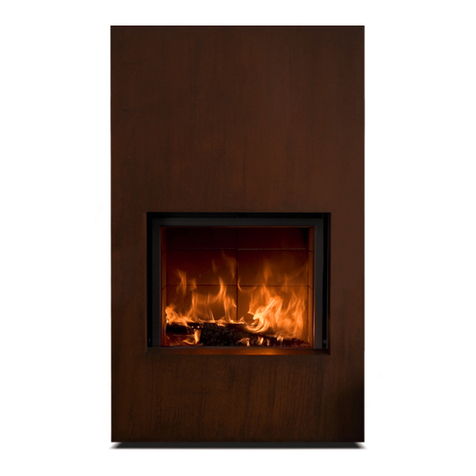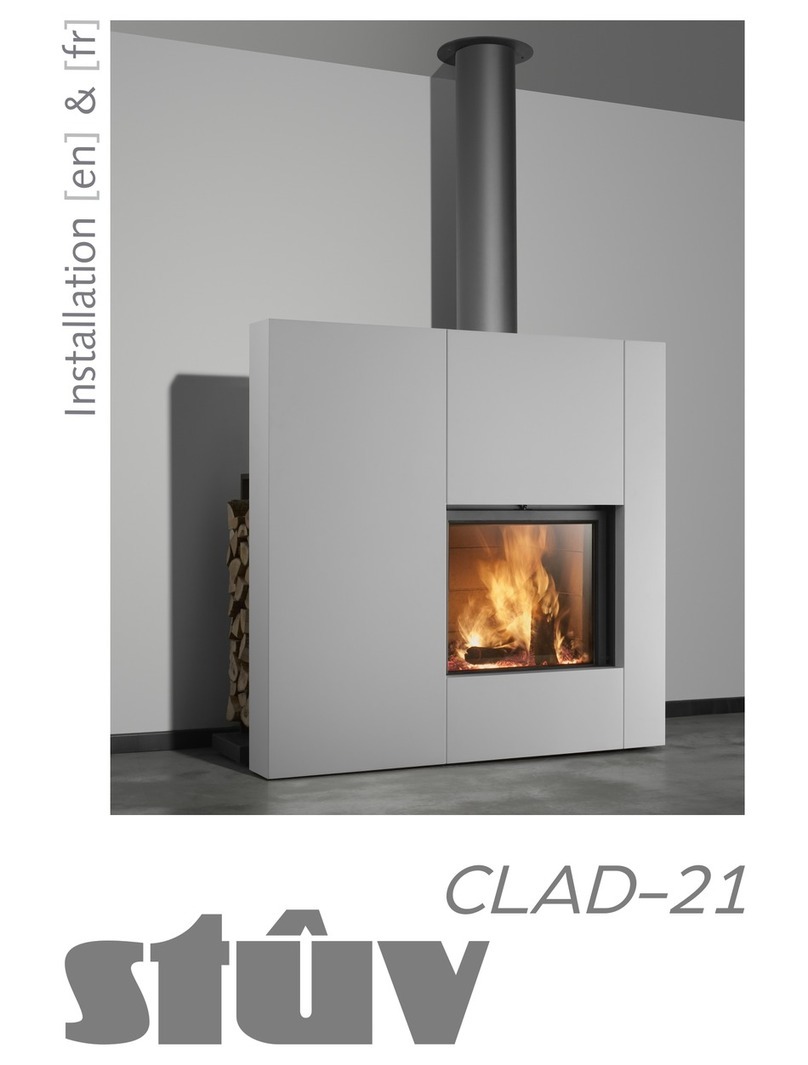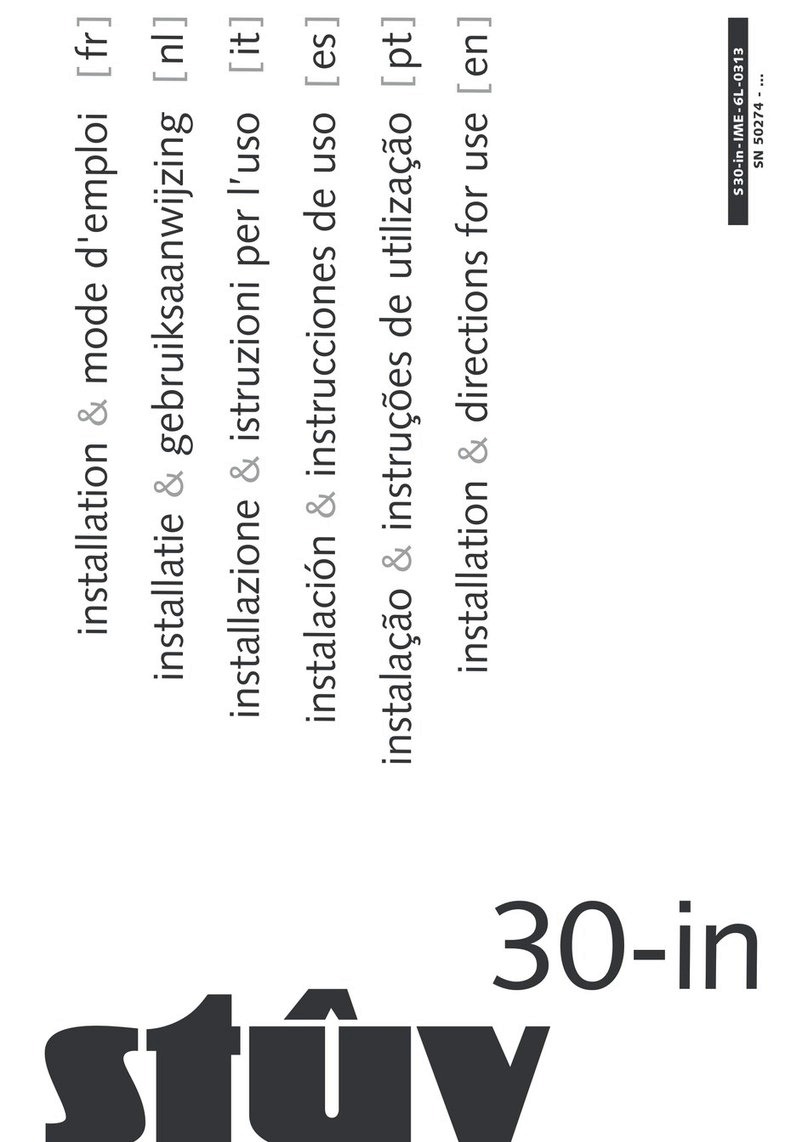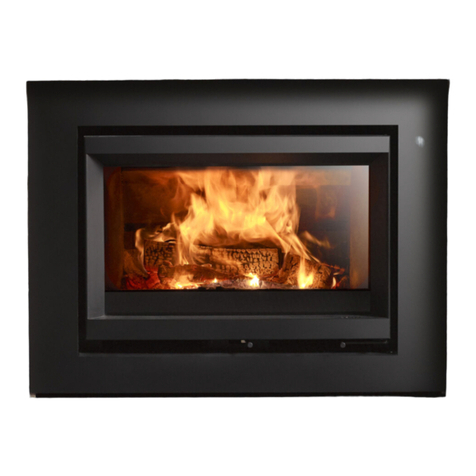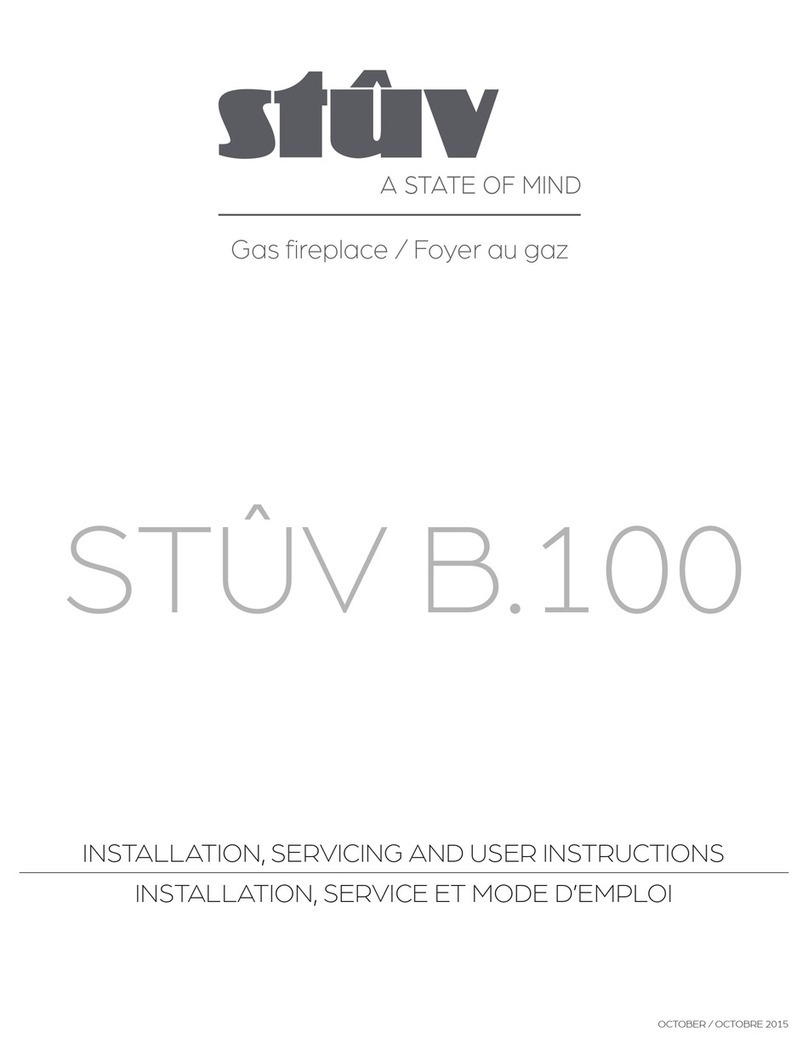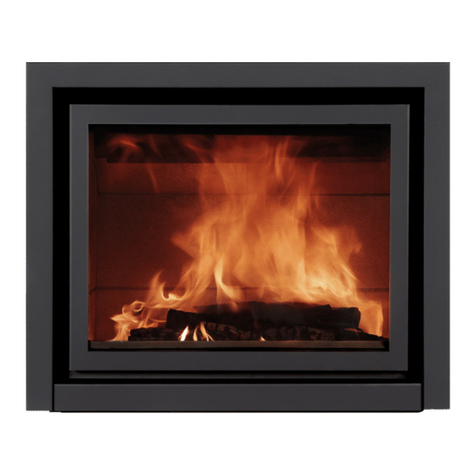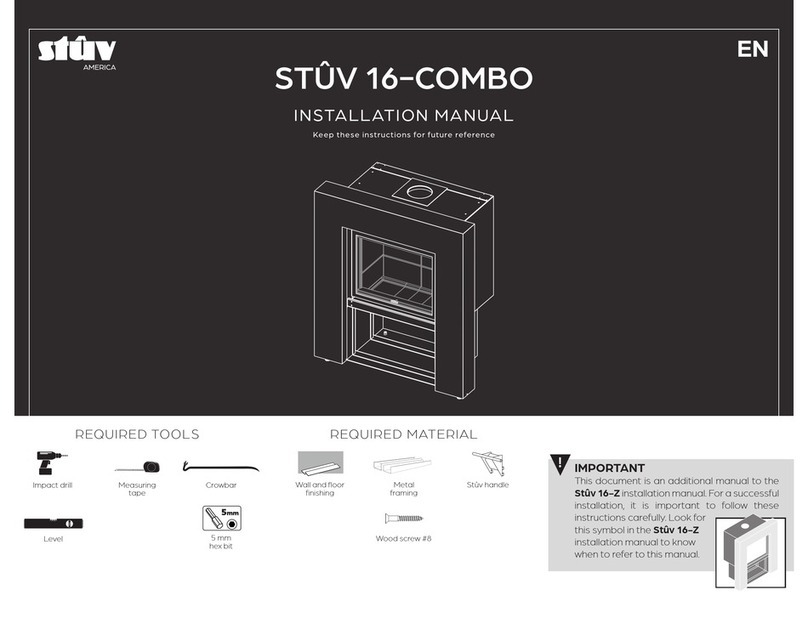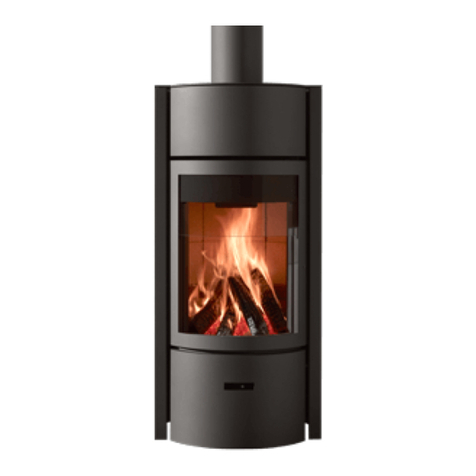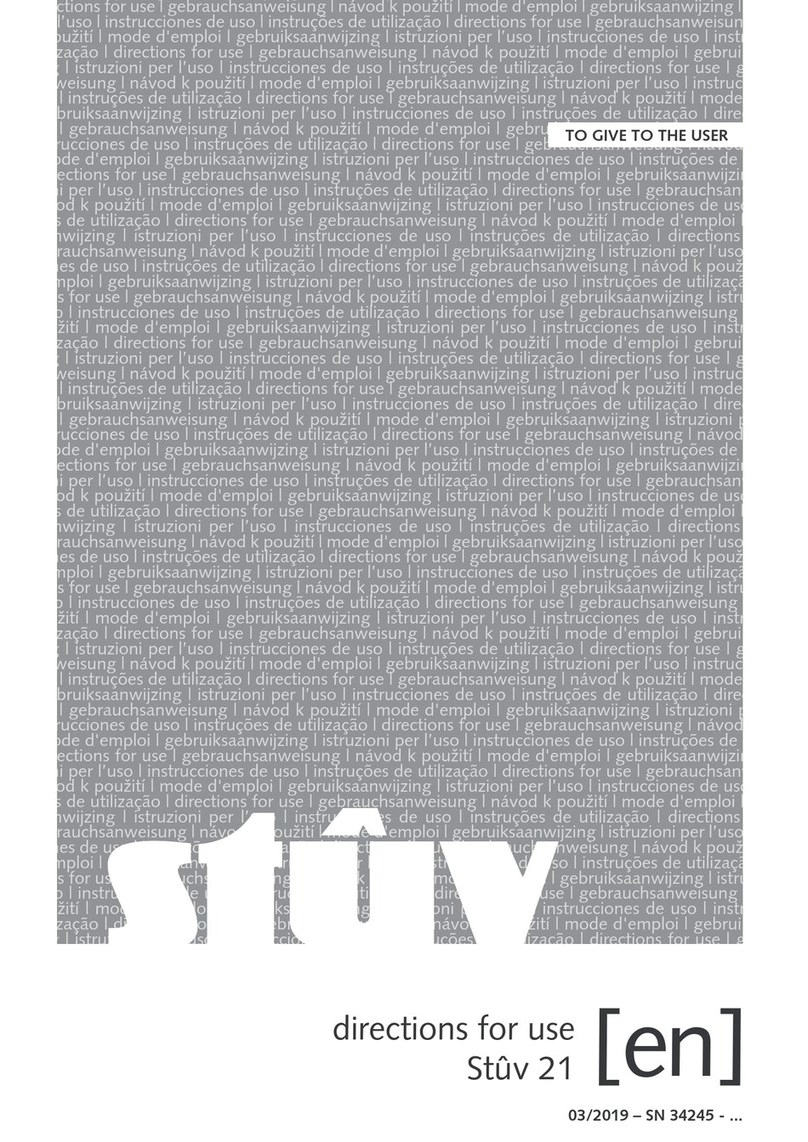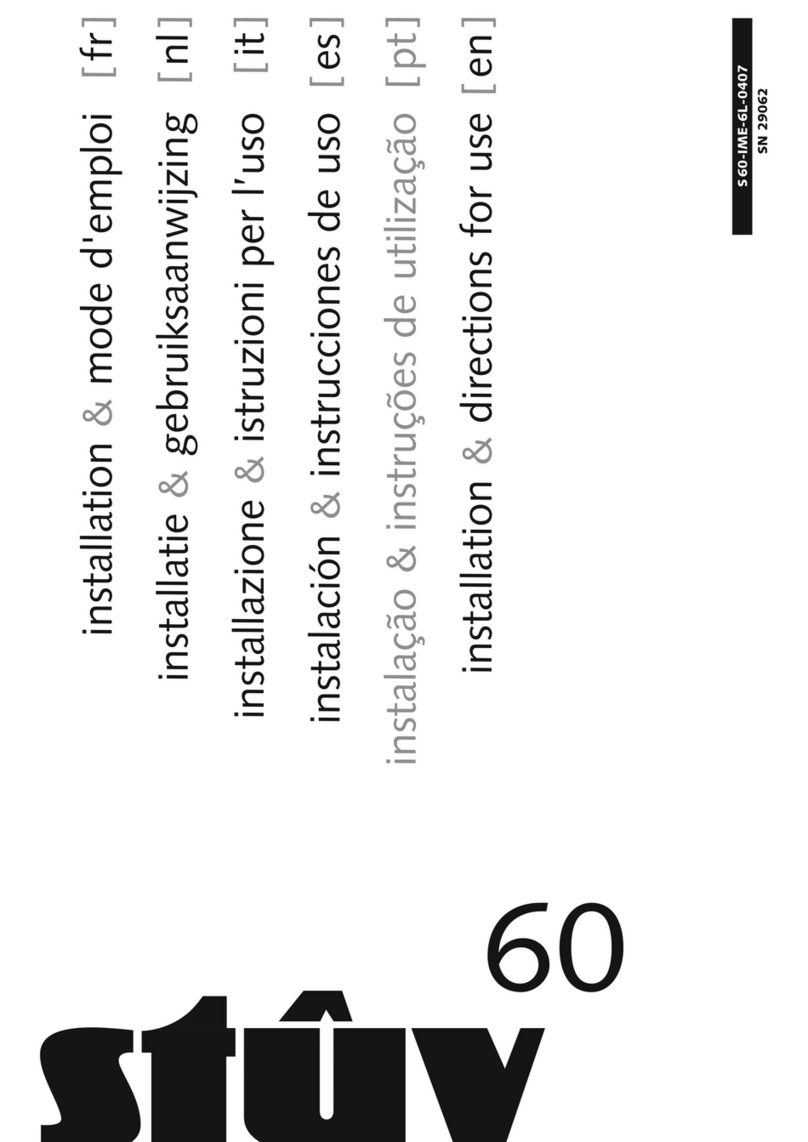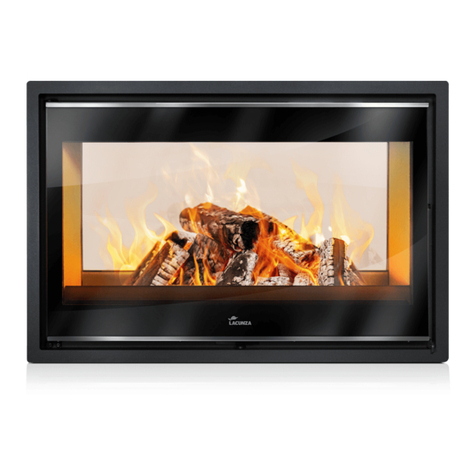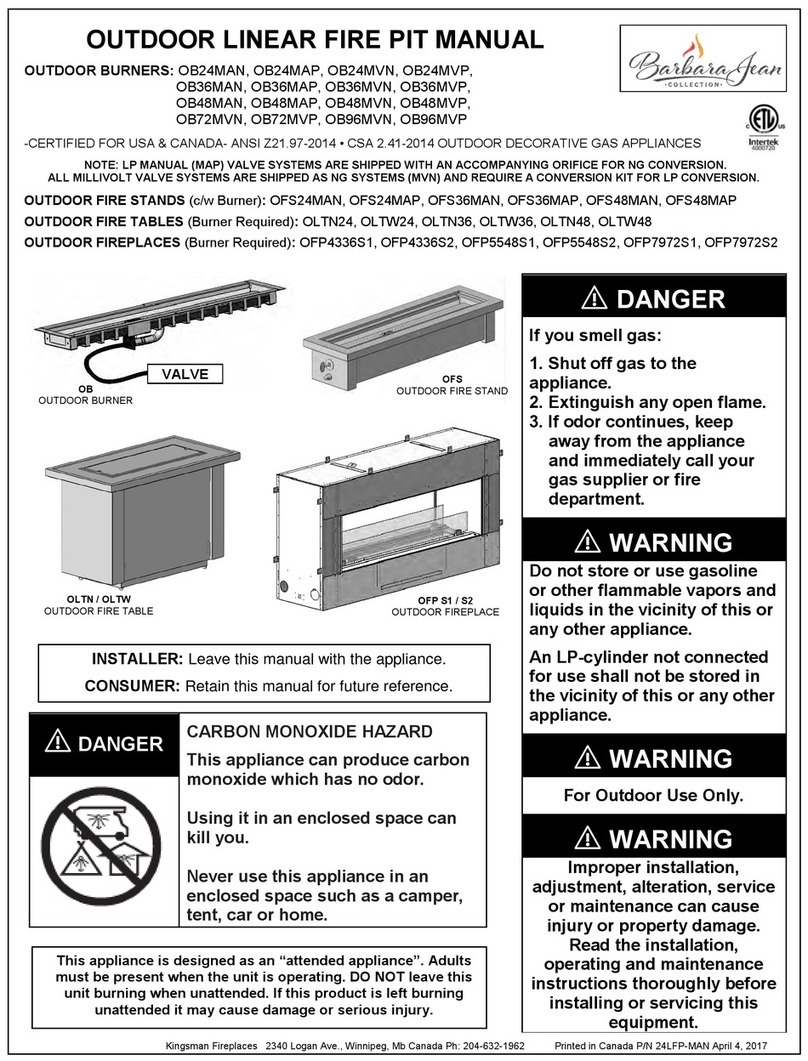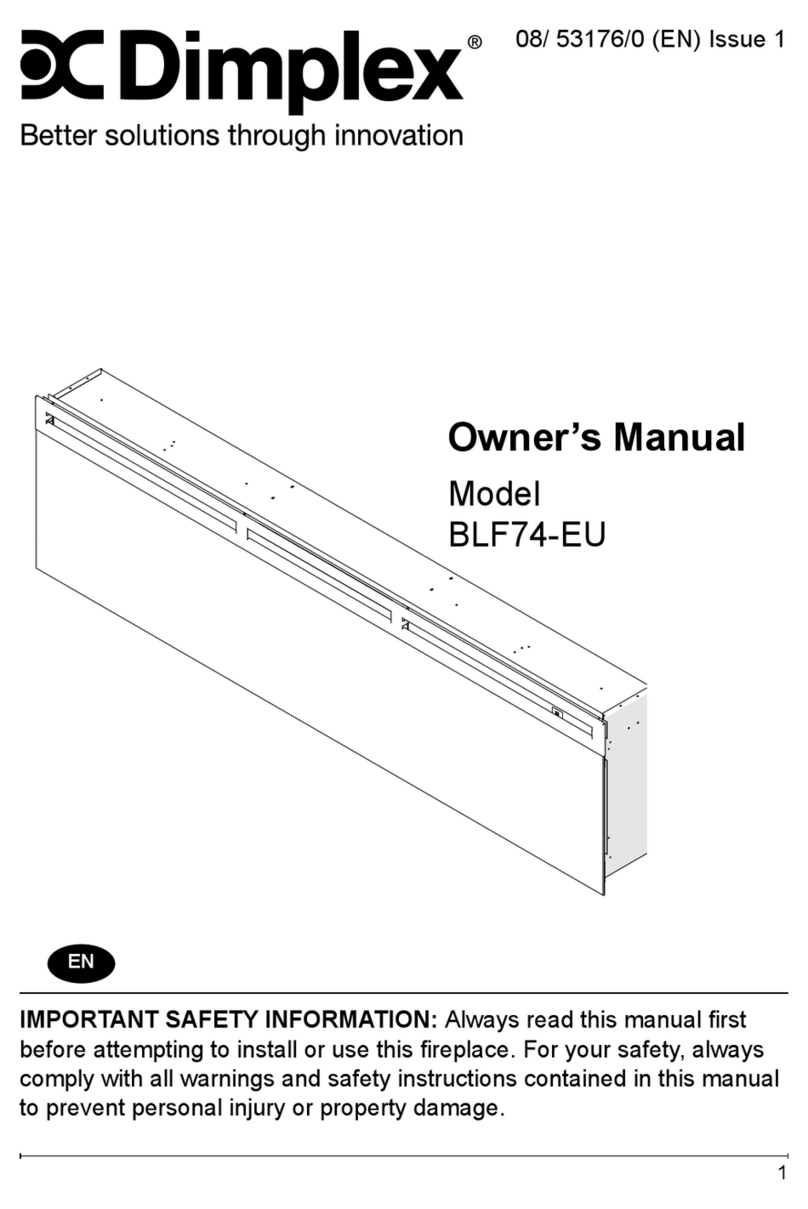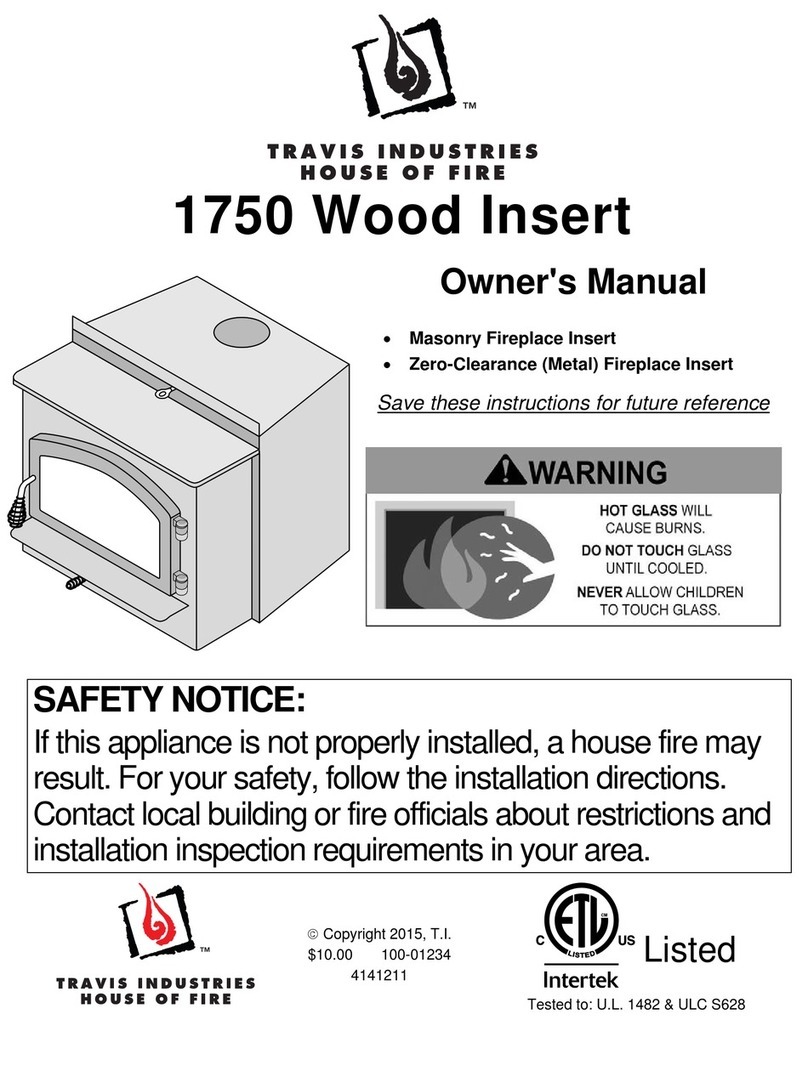Stuv 30 Compact Guide

3
0
0
-C
O
O
MPA
C
C
T

2

3
[en]
Technical specifications 4 » 8
Site preparation 9 » 14
Installation 15 » 30
Directions for use 31 » 57
Product registration and contact 58 » 61
[fr]
Présentation du produit 4 » 8
Préparation du chantier 9 » 14
Installation 15 » 30
Mode d’emploi 31 » 57
Enregistrement et contact 58 » 61

4
Your fireplace was designed to provide years of enjoyment,
comfort, and safety. It was built and assembled with the
greatest care. If, for any reason, you are dissatisfied with
your fireplace, please contact your retailer.
We recommend that you read the instructions before
proceeding with the installation.
With certain configurations, the sequence of operations to
be performed may slightly vary.
Standards, certifications and technical
specifications
This appliance has been tested and certified by CSA based
on the following standards:
UL-1482
ULC S-627
EPA PHASE 2
Safet
y
instructions
Before installing your Stûv, please contact the local building
authorities or the fire department and follow their
directives.
The installation of your Stûv should be entrusted to a skilled
professional.
If the Stûv fireplace is not properly installed, a fire could
result.
Your Stûv can be very hot: children and domestic animals
should not touch the fireplace when operating.
Combustible materials, such as firewood, wet clothes, etc.,
placed too close to the appliance could catch fire. Objects
placed in front of the fireplace should be kept at a distance
of at least 48” (1.22m) from the glass front.
Do not let the fireplace heat up until some parts glow red.
Burn the firewood directly on the refractor plates or the
iron. Do not use an andiron and do not try in any way to
raise the fire.
Do not install in a mobile home.
The installation instructions for your wood stove are
compliant with the ULC-S627 et UL-1482 standards. They
must be strictly followed in order to prevent any risk of
major problems. Please read carefully this manual before
Ce foyer a été conçu pour offrir un maximum de confort et
de sécurité. Le plus grand soin a été apporté à sa
fabrication. Si malgré cela vous constatiez une anomalie,
contactez votre revendeur.
Nous vous recommandons de lire cette notice avant de
procéder à l’installation.
Certaines configurations peuvent faire varier quelque peu
l’ordre des opérations à effectuer.
Normes, a
g
réations et caractéristiques
techniques
Cet appareil à été testé et certifié par CSA et selon les
normes suivantes :
UL-1482
ULC S-627
EPA PHASE 2
Instructions de sécurité
Avant d’installer votre Stûv, contactez les autorités locales
en bâtiment ou le service des incendies et suivez leurs
directives.
L’installation de votre Stûv doit être confiée à un
professionnel qualifié.
Si votre Stûv n’est pas installé de façon adéquate, un
incendie pourrait s’ensuivre. Votre Stûv peut devenir très
chaud : il faut empêcher les enfants et les animaux
domestiques de toucher le foyer lorsqu’il fonctionne.
Les matériaux combustibles tels que le bois de chauffage,
les vêtements mouillés, etc. placés trop près de l’appareil
pourraient prendre feu. Les objets placés devant l’appareil
doivent être gardés à une distance d’au moins 48" de la face
vitrée de l’appareil.
Ne laissez pas le foyer chauffer au point où des parties
deviennent rougeoyantes.
Brûlez le bois de chauffage directement sur les briques
réfractaires ou la fonte. N’utilisez pas de chenet et n’essayez
pas de surélever le feu de quelque façon.
Ne pas installer dans une maison mobile.
Les instructions concernant l’installation de votre poêle à
bois sont conformes aux normes ULC-S627 et UL-1482.
Vous devez les suivre rigoureusement afin d’éliminer tout
risque d’ennuis majeurs.

5
installing or operating your stove. If your stove is incorrectly
installed, a fire might result which would destroy your
house.
To reduce the risk of fire, follow the installation instructions.
Failure to follow instructions may result in property damage,
bodily injury, or even death.
Consult your local authorities or your insurance company
regarding all applicable regulatory requirements to obtain a
permit and to install your fireplace.
Keep this manual handy so you may refer to it whenever
necessary.
CAUTION:
•DO NOT USE CHEMICALS OR FLUIDS TO LIGHT THE
FIRE.
•DO NOT LEAVE THE STOVE UNATTENDED WHEN THE
DOOR IS SLIGHTLY OPENED.
•ALWAYS CLOSE THE DOOR AFTER THE IGNITION.
•DO NOT BURN GARBAGE, FLAMMABLE FLUIDS SUCH
AS GASOLINE, NAPHTHA OR ENGINE OIL.
•DO NOT CONNECT THE STOVE TO ANY HOT AIR
DISTRIBUTION SYSTEM.
•HOT WHILE IN OPERATION. KEEP CHILDREN,
CLOTHIN AND FURNITURE AWAY. CONTACT MAY
CAUSE SKIN BURN.
Note: We strongly recommend that our products
be installed and serviced by professionals certified
by the Association des Professionnels du Chauffage
in Quebec or by Wood Energy Technology Training
for the rest of Canada, or by the National Fireplace
Institute in the U.S.
Veuillez lire attentivement ce manuel avant d’installer ou
d’opérer votre poêle. Si votre poêle est mal installé, il peut
en résulter un incendie détruisant votre maison.
Pour réduire les risques d’incendie, suivez les instructions
d’installation. Le fait de ne pas respecter les instructions
peut occasionner des dommages à la propriété, des lésions
corporelles et même la mort.
Consultez le représentant de votre municipalité ou votre
compagnie d’assurance concernant les exigences locales
relatives aux permis et à l’installation de votre poêle.
Gardez ce manuel pour pouvoir le consulter ultérieurement
ATTENTION :
•NE PAS UTILISER DES PRODUITS CHIMIQUES OU
AUTRES LIQUIDES POUR ALLUMER LE FEU.
•NE JAMAIS LAISSER LE POÊLE SANS SURVEILLANCE
LORSQUE LA PORTE EST OUVERTE.
•TOUJOURS FERMER LA PORTE APRÈS LA PÉRIODE
D'ALLUMAGE.
•NE PAS BRÛLER DE DÉCHETS ET/OU DE LIQUIDES
INFLAMMABLES COMME L'ESSENCE, LA NAPHTA ET
L'HUILE DE MOTEUR.
•NE PAS CONNECTER LE POÊLE À UN SYSTÈME DE
DISTRIBUTION D'AIR CHAUD.
•L’APPAREIL EST CHAUD LORSQU’EN FONCTION.
GARDEZ LES ENFANTS, VÊTEMENTS ET MEUBLES
HORS DE PORTÉE. TOUCHER L’APPAREIL POURRAIT
CAUSER DES BRÛLURES.
Note : Nous recommandons fortement que nos
produits soient installés et entretenus par des
professionnels certifiés par l’Association des
Professionnels du Chauffage au Québec ou par
Wood Energy Technical Training pour le reste du
Canada, et par la National Fireplace Institute aux
États-Unis.

6
Technical specifications
Fuel type:
Cordwood
Stûv 30-compact
Maximum power: 30.000 BTU
Efficiency: 83 % (European data)
Chimney type: Insulated chimney 6” UL-103HT, ULC-S629
6” Double-wall connector
Unit weight: 250 lbs
Wood consumed per hour: 1 – 5,5 lbs / hour
Maximum length of logs in vertical position: 16”
Maximum length of logs in horizontal position: 10”
Marking Sticker
Caractéristiques techniques
principales des appareils
Type de combustible:
bûches de bois
Stûv 30-compact
Puissance maximale : 30.000 BTU
Efficacité : 83% (données européennes)
Type de cheminée : Conduit isolé 6” UL-103HT, ULC-S629
Connecteur à double parois de 6”
Poids de l’unité : 250 Lbs
Consommation bois/h : 1 -5,5 Lbs / heure
Longueur maximum des bûches (vertical) : 16”
Longueur maximum des bûches (horizontal) : 10”
Autocollant de marquage

7
DIMENSIONS & CLEARANCES DIMENSIONS & DÉGAGEMENTS
The clearances are indicated for all types of combustible
materials (e.g.: wood, gypsum, etc.).
Front clearance: 48"
Rear clearance: 8"
Side clearance: 8"
Minimum ceiling height: 84"
A flameproof protective material (no minimum R-value)
must be laid on the ground in front of the fireplace over a
length of 18" in front of the glass and 8" on each side of the
glass.
CLEARANCES MAY ONLY BE REDUCED BY MEANS
APPROVED BY THE REGULATORY AUTHORITY.
We recommend to store solid fuel (wood logs) in a clean
and dry environment. Caution: do not place such fuel
within space heater installation clearanes or within the space
required for charging and ash removal.
Les dégagements indiqués sont pour tout matériaux
combustible (ex.: Bois, Gypse, etc.).
Dégagement avant : 48"
Dégagement arrière : 8"
Dégagement des côtés : 8"
Hauteur minimum du plafond : 84"
Un matériel de protection incombustible (pas de valeur-R
minimal) doit être placé au sol à l'avant de l'appareil sur une
longueur de 18" devant la vitre et 8" de chaque côté de la
vitre.
LES DÉGAGEMENTS PRESCRITS NE PEUVENT ÊTRES
RÉDUITS QUE PAR DES MOYENS APPROUVÉS PAR UNE
AUTORITÉ DE RÉGULATION.
Nous vous recommandons de ranger le combustible solide
(bois de corde) dans un environnement propre et sec.
Attention : Ne placez pas ce genre de combustible dans
l’espace de dégagement d’instalation du poêle ou dans
l’espace de chargement ou de décendrage.

8

9
30-COMPACT

10
Combustion air inlet
The stove requires air for combustion (particularly when
working in open-fire mode).
The ideal solution
The Stûv 30-compact is designed to be directly connected to
an outside air inlet (independent of the air in the house). We
recommend this set-up. The connection can be made below
the stove [diagrams 1a & 2] or at the back [diagram 1b].
If the stove is not connected directly to an outside air
inlet...(optional)
A sufficient air inlet (Ø 2-1/2”) should ideally be created close
to the stove [diagram 3].
This air inlet comes from a ventilated empty space, a
ventilated room (cellar) or from outside.
This set-up is mandatory in some countries or localities.
Arrivée d’air pour la combustion
Le foyer a besoin d'air pour la combustion (particulièrement
lorsqu'il fonctionne à feu ouvert).
La solution idéale
Le Stûv 30-compact est conçu pour être connecté directement
à une arrivée d'air extérieur (indépendant de l'air de la
maison). Nous recommandons cette disposition. La connexion
peut se faire par en dessous du foyer [schémas 1a et 2] ou par
l'arrière [schéma 1b].
Si le foyer n'est pas directement raccordé à une arrivée d'air
extérieur… (facultatif)
Une arrivée d'air suffisante (ø 2-1/2”), doit idéalement
déboucher à proximité du foyer. [schéma 3].
Cette arrivée d’air proviendra d’un vide ventilé, d’un local
ventilé (cave) ou de l’extérieur.
Cette disposition est obligatoire dans certains pays ou localités.

11
The duct that brings in outside air… (whether it is connected
to the stove or not)
... will be protected on the outside by a grill [diagrams 2a-3a]
the free passage section of which is at least equivalent to the
section of the air inlet. Please note that the infiltration of water
and the effect of the wind can damage the system.
... will ideally be fitted with a closure valve (for example, the
Stûv damper – see below) [photo 4] to prevent the room from
becoming cold when the stove is not in use.
... will be as short as possible and insulated to prevent pressure
loss and to keep the house from getting cold.
If you use our standard flexible Ø 2 ½’’ duct, we recommend
a maximum length of 78’’ and no more than 4 elbows (see
table below).
If you exceed these guidelines, you must compensate with a
greater diameter and/or a smoother duct.
Careful not to crush the duct.
Length of flue Max. permitted ( 90°)
number of elbows
4’ 4 elbows
8’ 4 elbows
10’ 2 elbows
12’ 0 elbow
The closure damper
[diagram 3b and photo 4] prevents the house from becoming
cold when the stove is not in use.
This system is optional if you choose a connection directly to
the stove [diagrams 1and 2]. However, it is still a good idea if
the ducts are too long to reach the stove or if it is being
installed in an energy-efficient house.
It should ideally be located as close as possible to the outside
wall.
Caution: length of the valve control cable = 48’’ and damper
diameter is Ø6”. Plan to install a reducer.
If it is not possible to bring in outside air near the stove (most
unfavourable case)...
...ensure there is sufficient replenishment of air in the room
when the stove is in use.
Caution:
Be careful with active air extraction systems (kitchen hoods, air
conditioning, mechanically-controlled ventilation, and other
stoves) in operation in the same space or in an adjacent room.
They also use a lot of air and can cause a depression in the
room and prevent the stove from operating correctly (risk of
backdraught). They can affect the operation of the stove even
if it is connected to an outside air inlet.
Le conduit qui amène l'air extérieur... (qu'il soit connecté au
foyer ou pas)
... sera protégé à l'extérieur par une grille [schémas 2a-3a]
dont la section de passage libre est au moins équivalente à la
section d'arrivée d'air. Attention aux infiltrations d'eau et à
l'influence des vents qui peuvent annihiler le système.
... sera idéalement équipé d'un clapet de fermeture (par
exemple le clapet Stûv [photo 4]) pour éviter de refroidir la
pièce quand le foyer n'est pas en fonctionnement.
.... sera le plus court possible et isolé pour éviter des pertes de
charges et pour ne pas refroidir la maison.
Si vous utilisez notre conduit flexible standard ø 2 ½’’, nous
recommandons une longueur maximale 78’’ et pas plus de 4
coudes (voir tableau qui suit).
Si vous dépassez ces prescriptions, il faudra compenser par un
diamètre plus important et/ou un tube plus lisse.
Veiller à ne pas écraser le conduit.
Longueur du
conduit
Nombre max. de coudes (à
90°) autorisés
4’ 4 coudes
8’ 4 coudes
10’ 2 coudes
12’ 0 coudes
Le clapet de fermeture
[schéma 3b et photo 4] empêche le refroidissement de la
maison quand le foyer n'est pas en fonctionnement.
Ce dispositif est donc facultatif si vous optez pour un
raccordement direct sur le foyer [schémas 1 et 2]. Cependant,
il reste intéressant si les longueurs de gaines sont trop
importantes jusqu'au foyer ou si l'installation s'effectue dans
une maison à haute efficacité énergétique.
Il sera placé idéalement le plus près possible du mur extérieur.
Attention: longueur du câble de commande du clapet = 48’’
Et le diamètre du clapet est de ø 6’’. Prévoir un réducteur.
S'il n'est pas possible d'amener de l'air extérieur à proximité du
foyer (cas le plus défavorable)...
... s'assurer que le renouvellement d’air dans la pièce sera
toujours suffisant quand le foyer est en fonctionnement.
Note
Attention aux systèmes d’extraction actifs d’air (hotte de
cuisine, air-conditionné, ventilation mécanique contrôlée,
autre fo
y
er…) situés dans le même espace ou dans une pièce
contigüe. Ils consomment eux aussi beaucoup d'air et
pourraient créer une dépression dans le local et perturber le
bon fonctionnement du foyer (risque de refoulement). Ils
peuvent perturber le fonctionnement du foyer même si celui-ci
est raccordé à une arrivée d'air extérieur.

12
Connection to the chimne
y
Caution: Care must be taken during installation. Shortcuts or
compromises may result in safety hazards or even fire.
Do not connect the unit to a chimney used for another
appliance.
Do not cut rafters or ceiling joints without first consulting a
building official to ensure that structural integrity is not
compromised.
Use a 6-inch clearance double-walled connector (black). Use
only a 6-inch insulated flue in compliance with the UL 103 HT
or ULC S629 standard as soon as you go through a
combustible wall, in compliance with your local installation
standards. This connector will be fixed to the smoke outlet
using 3 self tapng screws #10-1/2”.
A CHIMNEY SERVING AS AN OUTLET FOR A FIREPLACE
CANNOT BE USED FOR ANY OTHER APPLIANCE.
CAUTION: PLEASE REFER TO THE INSTRUCTION MANUAL
OF THE CHIMNEY MANUFACTURER FOR THE
INSTALLATION DETAILS.
CAUTION: If this appliance is not correctly installed, a fire
might result. To reduce fire hazards, follow the installation
instructions. Consult local authorities to obtain a construction
permit and to know all applicable regulatory requirements.
Raccordement à la cheminée
Attention: N’employez pas de moyens de fortune pendant
l’installation: ils pourraient devenir dangereux et entraîner un
incendie.
Ne reliez pas cet appareil à une cheminée qui dessert un autre
appareil de chauffage.
Ne coupez ni chevrons ni solives de plafond sans consulter au
préalable un agent du service du bâtiment pour éviter de
compromettre l’Intégralité Structurale.
Utiliser un connecteur à doubles parois (noir) à dégagement
de 6 pouces. Utiliser uniquement un conduit isolé de 6 pouces
répertorié selon la norme UL 103 HT ou ULC S-629 dès que
vous traversez une paroi combustible, selon les normes
d’installations en vigueur dans votre localité. Ce connecteur
sera fixé à la buse de l’appareil utilisant 3 vis auto-forantes
#10-1/2".
UNE CHEMINÉE SERVANT D’ÉVACUATION À UN FOYER NE
DOIT PAS SERVIR POUR AUCUN AUTRE APPAREIL.
ATTENTION : VEUILLEZ VOUS RÉFÉRER AU MANUEL
D’INSTRUCTION DU MANUFACTURIER DE CHEMINÉE
POUR LES DÉTAILS D’INSTALLATION DE LA CHEMINÉE.
PRÉCAUTIONS: Si cet appareil n’est pas adéquatement
installé, un incendie peut s’ensuivre. Afin de réduire tout
risque d’incendie, suivez les instructions d’installation.
Consultez les autorités locales pour obtenir un permis de
construction ainsi que de prendre connaissance de toutes les
exigences règlementaires en vigueur.

13
Holdin
g
capacit
y
of the structure
Ensure that the floor is resistant enough to support the stove;
consult a specialist if in doubt.
The stove’s surroundin
g
s
The heat radiated from the glass door and the unit may be
significant. Whichever direction the stove is facing, please
adhere to the safety distances from combustible materials
[diagram 1] or ensure that the materials exposed to radiate
heat are resistant to high temperatures.
Prevent "heat traps" in the cladding, recess and hood
If the stove is situated in a bell-shaped area (e.g.: a former
hearth), this space must be ventilated to prevent "heat traps".
Tools required
Capacité portante de la structure
S'assurer que la résistance du plancher soit suffisante pour supporter
le foyer ; en cas de doute, consulter un spécialiste.
Environnement du fo
y
er
Rayonnement
Le rayonnement de la vitre et des parois peut être important.
Quelque soit l'orientation du fo
y
er rotatif, respectez les
distances de sécurité par rapport aux matériaux combustibles
[schéma 1], ou assurez-vous que les matériaux exposés à ce
rayonnement soient résistants à de hautes températures.
Éviter les "pièges à chaleur" dans l'habilla
g
e, la niche ou la
hotte
Si le poêle se situe dans un environnement en forme de cloche
(ex : ancien âtre), cet espace doit être ventilé pour éviter les
"pièges à chaleur».
Outils à prévoir

14

15
30-COMPACT

16
On takin
g
deliver
y
of the equipment
Caution:
As soon as the stove is delivered, please check that the glasses
have not been broken during delivery. The guarantee only
covers damage due to transport if it is reported within 48
hours of delivery and if it is indicated on the delivery slip.
Claims
If you wish to make a complaint, always quote the serial
number visible on the stove in the closed-door position
[photo 1].
Optional accessories
– ground plate
– barbecuekit
– kit for rear outside air intake
If any of these accessories have been ordered, they will be
found around the stove or its packaging. Check that you have
received them.
Stove transportation
Caution:
The paint is not oven-baked and is therefore relatively fragile
but it will harden after being heated a few times. Therefore,
handle the system with care when installing.
Moving
While the stove is still packa
g
ed,
y
ou can use a pallet loader or
a hand-lift truck [photo 2]. Move it close to its final position.
If you are unable to transport the stove on its pallet to its final
position, please observe the following unpacking instructions.
À la réception du matériel
Attention !
Dès la réception de ce foyer, veuillez vérifier que les vitres ne
se soient pas brisées au cours de la livraison. En effet, la
garantie ne couvre les détériorations dues au transport que si
elles ont été signalées dans les 48 heures suivant la réception
et qu’elles aient été mentionnées sur le bon de livraison.
Réclamation
En cas de réclamation, communiquez toujours le n° de série
visible sur foyer en position porte pleine [photo 1].
Accessoires Optionnels
– plaque de sol
– kit barbecue
– kit d'adduction d'air extérieur par l'arrière
Si un ou plusieurs de ces accessoires ont été commandés, ils
sont disposés autour du foyer ou de son emballage. En
contrôler la bonne réception.
Transport du fo
y
er
Attention !
La peinture n'est pas cuite au four, elle est donc relativement
fragile mais elle durcira lors des premières chauffes ; par
conséquent, manipuler l'appareil avec précaution lors de son
installation.
Déplacement
Quand le foyer est toujours emballé, vous pouvez utiliser un
transpalette ou un diable [photo 2]. Amenez-le à proximité de
son emplacement définitif.
Si vous n'avez pas la possibilité de transporter le fo
y
er sur sa
palette jusqu'à son emplacement définitif, veuillez suivre les
instructions de déballage qui suivent.

17
Unpackin
g
> Remove the wooden structure [photo 1] using a claw
hammer.
> Remove the plastic packaging [photo 2] and the plastic
films at the top and bottom of the stove which hold the
mobile parts in place during transport [photo 3].
Note: The hand-lift truck protection [photo 4] supports the
stove during handling to avoid putting pressure on the doors
or the drum. It is later removed when the stove is moved into
its final position.
Caution: Never loosen the two screws holding the support
panel in place: it is factory adjusted and fixed
[photo 5].
Déballa
g
e
> Retirer la structure en bois [photo 1] à l’aide du pied de
biche.
> Retirer l'emballage plastique [photo 2] et les films plastiques
en haut et en bas du fo
y
er qui maintiennent les parties mobiles
pendant le transport [photo 3].
Remarque! La protection transport diable [photo 4] sert à
appuyer le foyer pendant la manutention pour ne pas forcer
sur les portes ou le tambour. Elle sera retirée plus tard quand
le foyer aura été amené à sa place définitive.
Attention! Ne jamais desserrer les deux vis positionnant le
support parement : celui-ci a été réglé et fixé en usine
[photo 5].

18
Removin
g
the exterior parts of the stove
To make the stove lighter, easier to handle and to avoid
damaging the mobile parts, we strongly recommend that you
unpack the Stûv 30-compact and remove the contents from
the combustion chamber before starting the actual installation.
> Remove the 2 plates on the top of the stove:
on the Stûv 30-compact simply remove the one at the back
and then the one at the front [photo 1].
> Remove the side panels using a size 10 socket wrench
[photos 2 and 3].
> Carefully cut the plastic film holding the doors [photo 4].
Do not tear this film off! One of the ends of this film is stuck
between the solid door and the body of the stove. Unlock and
open the door using the cold grip to release it.
> Remove the hand-lift truck protection:
– open the door and unscrew the two bolts (M6x12
hexagonal heads) holding the hand-lift truck protection in
place [photo 5 and 6].
– pick up the 2 bolts and close the door.
Démonta
g
e des pièces extérieures du fo
y
er
Pour alléger le foyer, le manipuler plus facilement et éviter
d'abîmer les pièces mobiles, nous vous conseillons vivement de
déshabiller le Stûv 30-compact de ses parements avant de
commencer l'installation proprement dite.
> Retirer les 2 tablettes situées sur le haut du foyer :
retirer simplement celle de l'arrière puis celle de l'avant [photo
1].
> Retirer les parements latéraux à l’aide de la clé à douille de
10mm [photos 2 et 3].
> Couper avec précaution le film plastique qui maintient les
portes [photo 4]. Ne pas arracher le film ! Une des extrémités
de ce film est coincée entre la porte pleine et le corps du fo
y
er.
Déverrouiller et ouvrir la porte à l'aide de la main froide pour
le décoincer.
> Retirer la protection transport diable :
– ouvrir la porte et dévisser les deux boulons (M6x12 tête
hexagonale) qui maintiennent la protection transport diable
[photo 5 et 6].
– récupérer les 2 écrous et fermer la porte.

19
> Remove the ash pan: open the ash pan door [photo 7] and
take it out by lifting it off its hinges [photo 8].
> Remove the doors: half open them gently [photo 9], lift
them off their hinges and slide them to the left [photo 10].
Caution:
When you handle symmetrical parts while dismantling,
remember to take note which are the left parts and
which are the right ones! It will make re-assembly easier.
> Retirer le portillon cendrier : ouvrir le portillon cendrier
[photo 7] et le retirer en le dégageant de ses gonds [photo 8].
> Retirer les portes : les entrouvrir légèrement [photo 9], les
soulever pour les sortir de leurs gonds puis les pousser vers la
gauche [photo 10].
Attention !
Lorsque vous manipulez des pièces symétriques pendant le
démontage, pensez à bien mémoriser quelles sont les pièces
de gauche et celles de droite ! Cela vous facilitera le
remontage.

20
Content of the combustion chamber
Checking the contents of the combustion chamber [photo 1]
You will find:
– a spray paint for touching up [photo 1/a]
– a cold grip to handle the door and the damper [photo 1/b]
– 2 rotation stops and 2 M5x6 screws [photo 1/c]
– a sealing plate and 2 M5x8 screws [photo 1/d]
– installation instructions
– instructions for use
Removin
g
the smoke deflector
The smoke deflector has been locked down to prevent
damage during transport. Remove the two blocking screws
from the inside [photo 2].
Tilt and gently slide the smoke deflector towards the back
[photos 3 and 4]. Turn it clockwise to release the deflector and
its control [photo 5]. Let the deflector drop down [photo 6].
Contenu de la chambre de combustion
Vérification du contenu de la chambre de combustion
[photo 1]
Vous trouverez :
– une bombe de peinture pour retouches [photo 1a]
– une poignée “main froide” pour manipuler la porte et le
registre [photo 1b]
– 2 butées de rotation et 2 vis M5 x 6 [photo 1c]
– une plaque d'obturation et 2 vis M5 x 8 [photo 1d]
– notice d'installation
– notice mode d'emploi
Retrait du déviateur de fumées
le déviateur de fumées a été verrouillé pour éviter des
dommages pendant le transport. Enlever les deux vis de
blocage par l'intérieur [photo 2].
Incliner et
g
lisser lé
g
èrement vers l'arrière le déviateur de
fumées [photos 3 et 4]. Le faire pivoter dans le sens horaire
pour découpler le déviateur de sa commande [photo 5].
Laisser descendre le déviateur [photo 6].
Other manuals for 30 Compact
7
Table of contents
Other Stuv Indoor Fireplace manuals
Popular Indoor Fireplace manuals by other brands

RSF Woodburning Fireplaces
RSF Woodburning Fireplaces OPEL+ KEYSTONE owner's manual

Continental Fireplaces
Continental Fireplaces CEFB36H-BS manual

Wildfire
Wildfire CERALIS User instructions
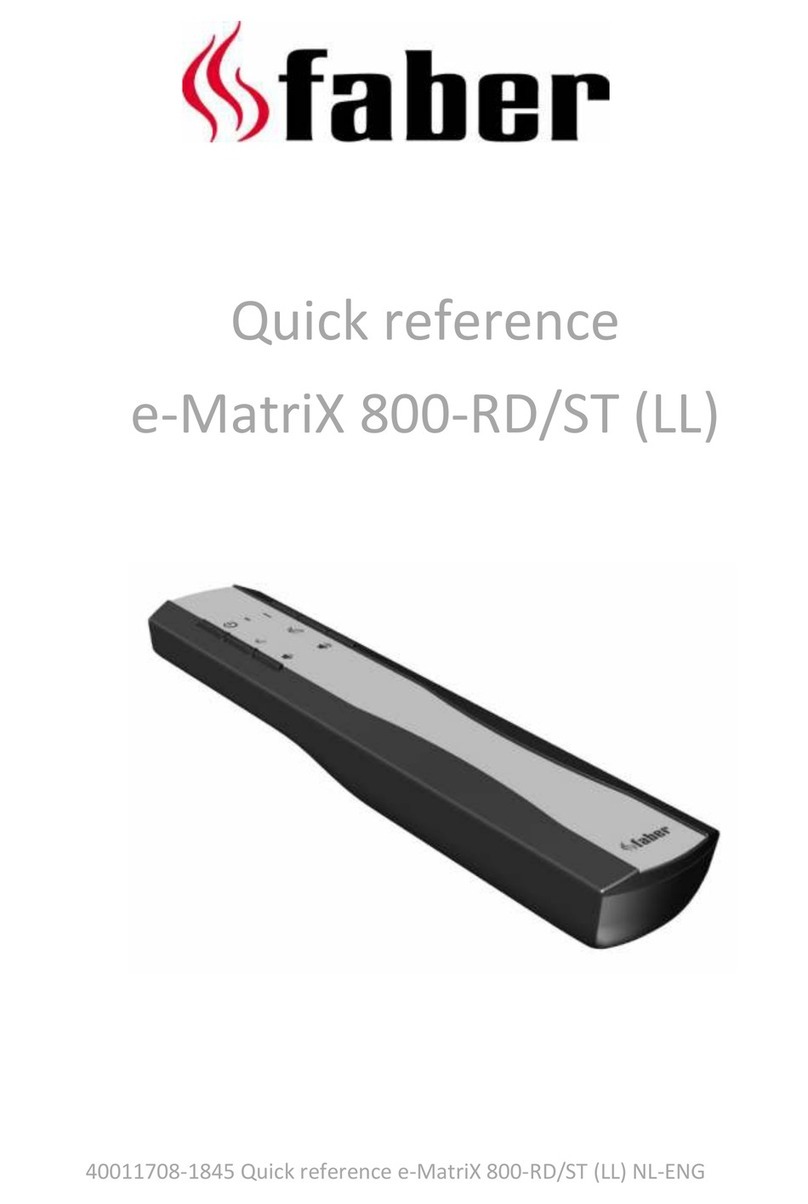
Faber
Faber e-MatriX 800x500-RD quick reference
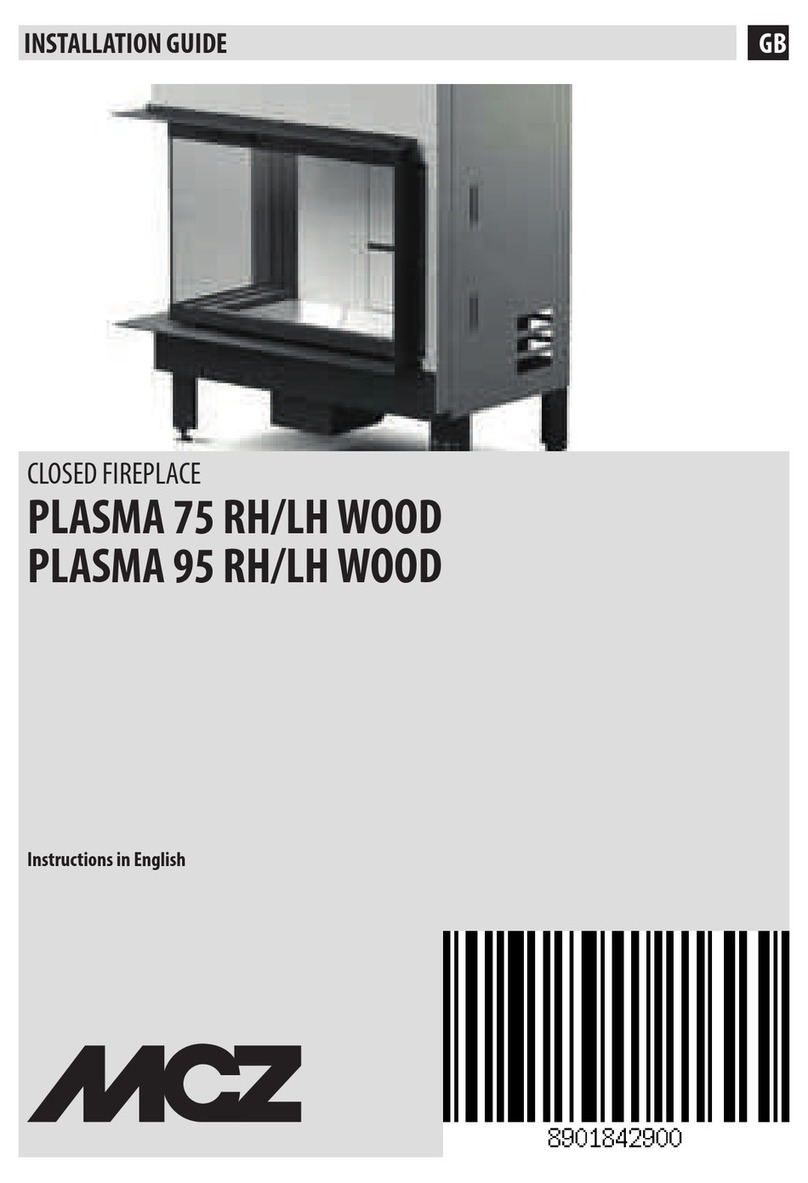
MCZ
MCZ PLASMA 75 LH WOOD installation guide
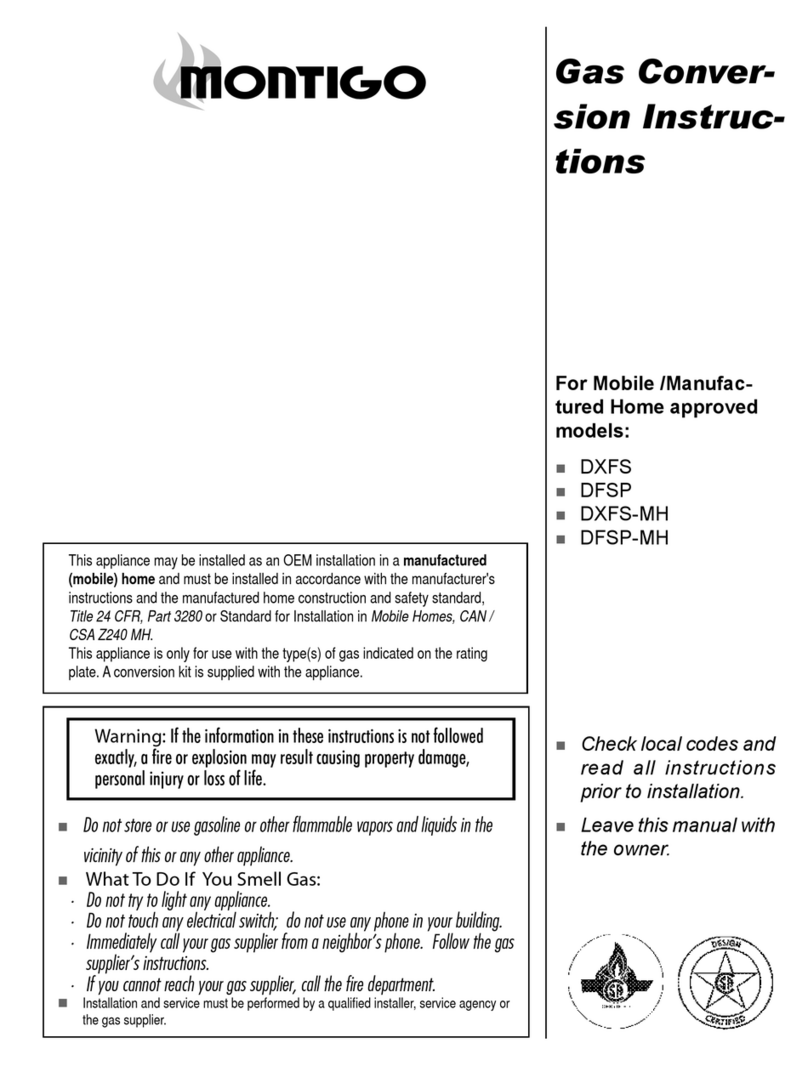
Montigo
Montigo DFSP supplementary guide

Elmira Stove Works
Elmira Stove Works WH-046654 owner's manual
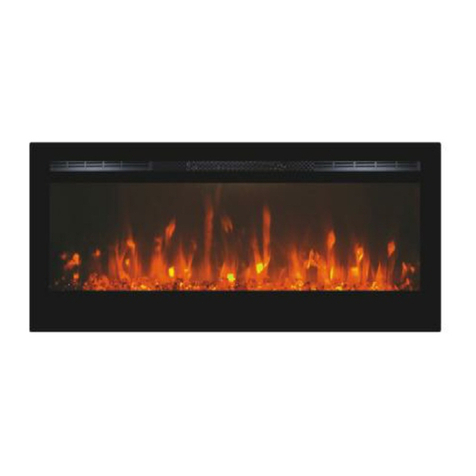
CSA
CSA BG-36B owner's manual

Desa
Desa VJM36 Series OWNER'S OPERATION AND INSTALLATION MANUAL

ESPRIT
ESPRIT ESPR.BODYB Installation and operating instructions
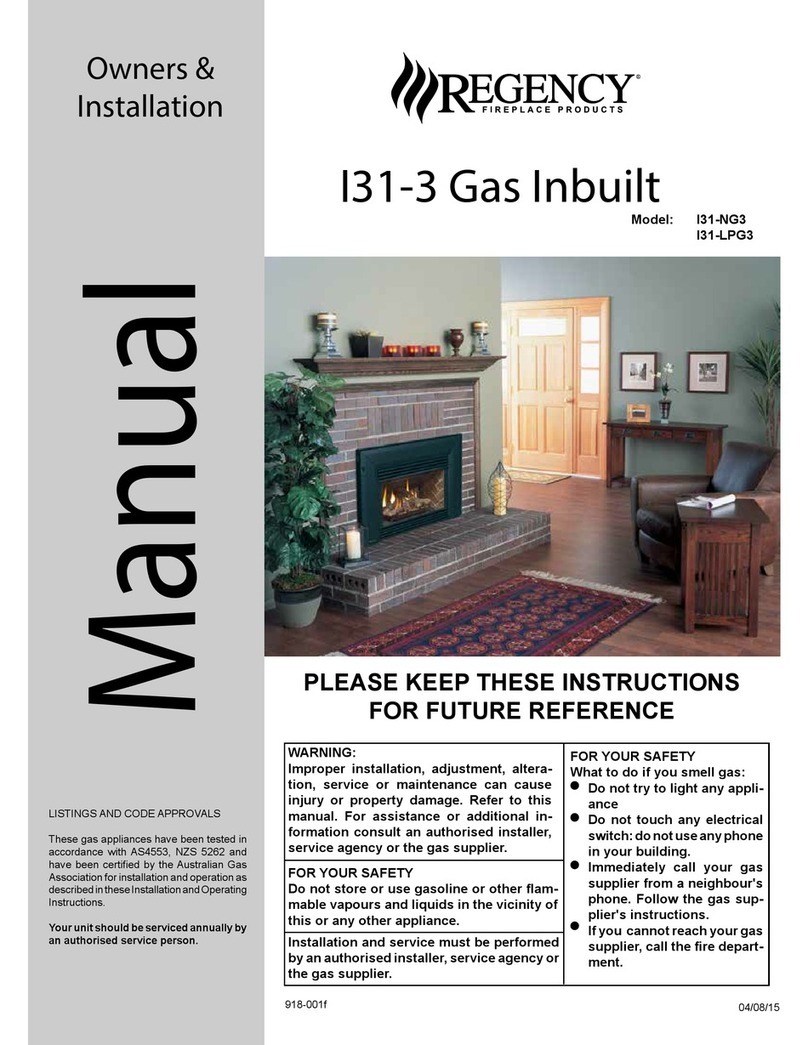
Regency
Regency I31-NG3 Owners & installation manual
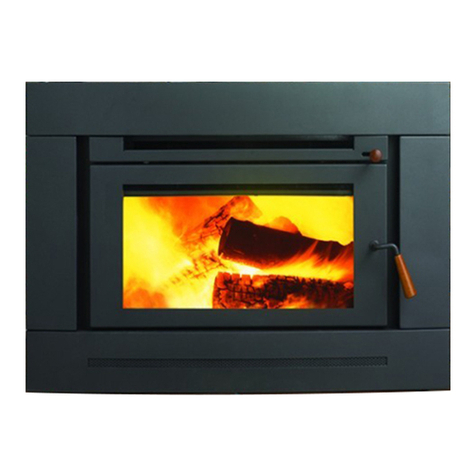
Regency
Regency Bellerive I200B Owners & installation manual





